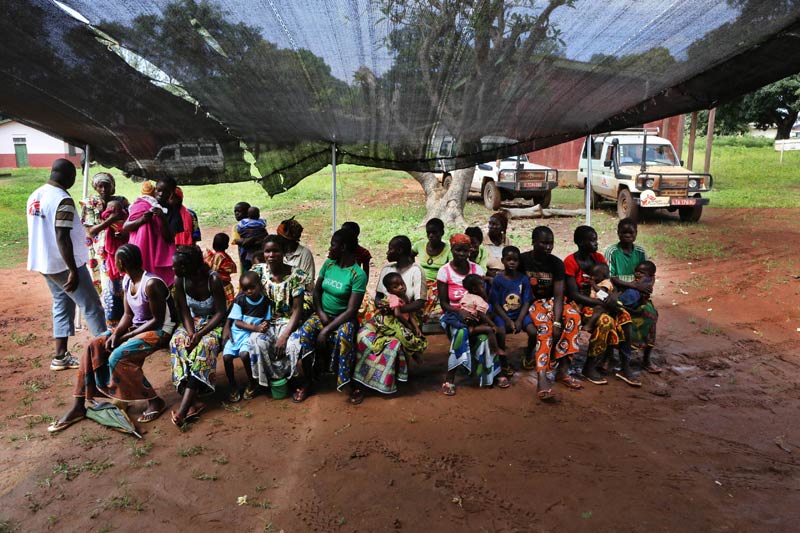The Central African Republic is in danger of becoming the world’s latest failed state, with increasing sectarian violence sparking a humanitarian disaster. Médecins Sans Frontières’ Dutch general director, Arjan Hehenkamp, has recently returned from the country. He sent this harrowing report:
I’m just back from Bossangao, a town of 45 000 people 330km northwest of the capital, Bangui. From the air, you can see tin rooftops and big compounds, and it looks like a prosperous and bustling regional centre. But then you start looking for people and you see that there’s no one there – all the houses are deserted. Most of Bossangao’s inhabitants have gathered in a church compound, an area the size of nine football pitches, where 30 000 people are enclosed by their own fear.

The country has been gripped by violence since the coup d’etat in March, and religion is becoming a part of the conflict – basically everyone is scared of being targeted by everyone else.
The church compound is like an open-air prison. People don’t even dare to go and fetch the wood they need for cooking. They don’t dare to go out of that protected zone back to their houses – where they would have a roof over their heads and some proper facilities – even though their houses are sometimes only a few hundred metres away.

When you walk into the compound, you’re faced by a teeming mass of people, and you have to navigate through all the families that have set themselves up there. They’re living, they’re cooking, they’re defecating, all in the same compound, and they’ve been there for three weeks. They’ve recently got some shelter materials, but otherwise they’re living in the open air, surrounded by mud and garbage.
Our medical teams are working in the compound, and we’ve set up water and sanitation facilities. We’re pulling out all the stops to provide them with basic amenities and medical care, but at the end of the day it’s an untenable situation. It’s just not suitable for a 30 000-strong group of people – the risk of disease outbreaks is too great.
There are 1 000 to 1 500 people, also mostly Christians, staying in another protected zone around the hospital – they have slightly more space, but in essence it’s the same thing. And there’s a 500-strong group of mostly Muslims in a school nearby – testament to the religious divisions that have crept into the conflict.

We are working in the church compound, and also in the hospital, with both international and local staff. The hospital provides inpatient, outpatient and surgical services, and is functioning at a reasonable level, but it needs to be cranked up in order to deal with the numbers of patients we’re seeing and the kinds of injuries they’re arriving with – injuries which are quite horrific and difficult to treat.
One of our patients was a man who had been shot four times in the back, and his head had been partially hacked off by a machete. The surgeon tried to sew it back on and save the patient, but sadly he died.
Another was a child from a village outside Bossangao. His parents had tied him to the house with chains because he had diabetes and was prone to running around and having fits. But they lost the key to the padlock, so when they had to flee into the bush they couldn’t take him with them. When they came back he was still alive, but he had been slashed badly across his arms when he held them up to protect himself.

This is the level of brutality and violence that is affecting people, and we are probably only seeing a part of it. Outside Bossangoa, we know there are troops and local defence groups going around and seeking people out, engaging in targeted killing or small-scale massacres. Our teams have come across sites of executions, and some have actually witnessed executions.
The villages along the road from Bossangao to Bangui are deserted. For 120km, there’s no one there – 100 000 people have disappeared and fled into the bush. We can’t reach them, and they can’t reach our services. This is a major humanitarian and medical concern.
Compared to last year, when there was already a chronic humanitarian crisis in Central African Republic, the crisis has doubled, the capacity of the state has vanished completely, and the humanitarian capacity has halved.
There’s an acute need for aid organisations to deploy themselves with an international presence outside the capital, and in particular for the UN to lead the way in doing so. An international presence has a protective effect – I’m pretty sure that if MSF had not been present in Bossangoa, the level of violence and killings would have been much higher than it was.
Since the armed takeover in March, the violence hasn’t really abated. There have been violent reprisals and counter-reprisals. The violence continues, but now it is just more targeted and out of sight.
